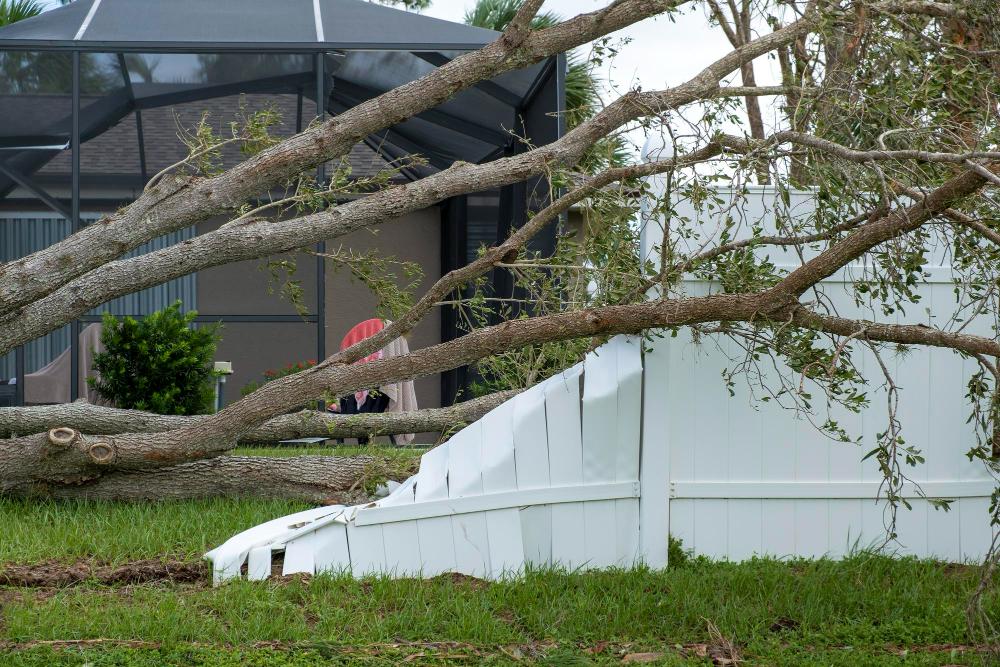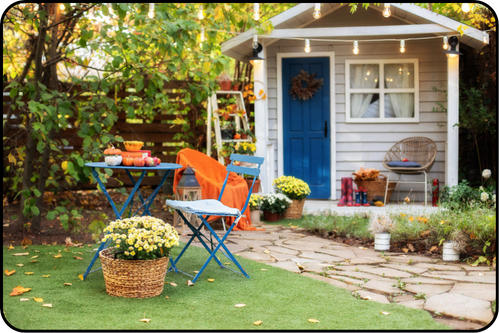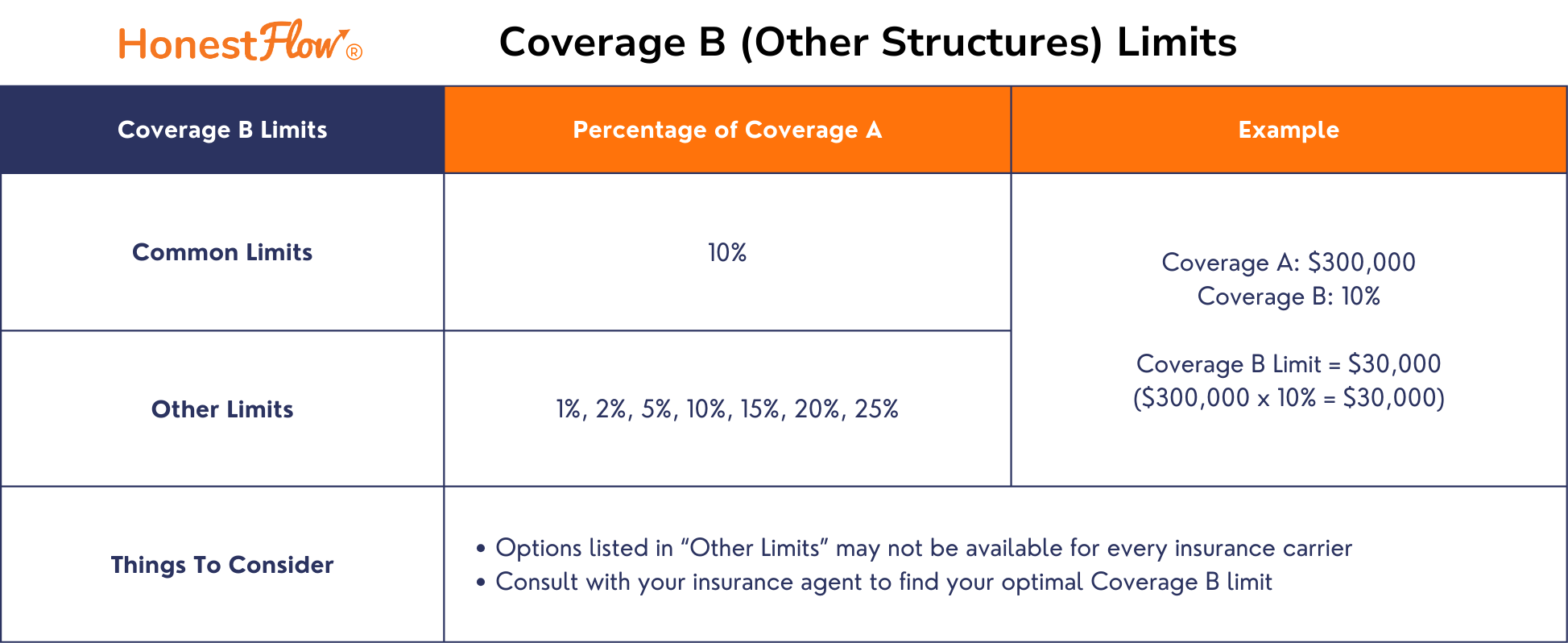
Understanding Home Insurance - Other Structures Coverage (Coverage B)
Disclaimer: The content on our blog is intended for general informational and educational purposes only and should not be considered a substitute for professional advice. Insurance needs vary widely, and because insurance companies and policies differ, readers should consult with their insurance agent for personalized guidance. While we strive for accuracy and regularly update our content, we cannot guarantee its completeness or timeliness. HonestFlow is not responsible for any actions taken on insurance policies based on the information provided on our blog.
What is Other Structures Coverage?

Coverage B in home insurance, commonly known as "Other Structures Coverage," is designed to safeguard structures detached from the main house, such as detached garages, fences, or sheds. This coverage protects these structures from a range of covered risks (perils).
Why is Coverage B Important?
Coverage B is essential because it helps ensure that the detached structures on your property are protected by your home insurance policy. Without this coverage, any damage to these detached structures would be the policyholder's financial responsibility, which could be significant depending on the extent of the damage and the value of the structures.
What's Covered Under Coverage B?

This table provides a general overview of coverage and exclusions under Coverage B (Other Structures). The specifics of your policy can vary based on your insurance carrier and individual policy details. For accurate and detailed information about your coverage, please consult with your insurance agent.
✅ Protection for Other Structures
Coverage B in home insurance protects detached structures on your property. This includes a wide range of detached structures such as detached garages, sheds, fences, and gazebos. A primary function of Coverage B is to provide financial protection against damage or loss to these detached structures from covered perils. These perils typically include risks like fires, storms, and vandalism, but it's essential to confirm the specific perils covered with your insurance agent, as they can vary between policy types and insurance carriers.
🔍 Scope of Coverage
Coverage B generally protects detached structures; however, some detached structures may need a separate endorsement for full coverage. For example, a property with a detached guest home may require higher coverage limits or a separate endorsement to be covered. Additionally, some structures can be partially attached, adding confusion to what is covered under this section of the policy. It’s crucial to understand how your policy protects detached structures and to know which structures are covered under this section. If you're unsure which structures are considered "detached," working with a dedicated agent can provide you with clear answers.
❌ Understanding Exclusions
Similar to other home insurance coverages, Coverage B has its own set of exclusions. Damages resulting from certain natural disasters, such as floods and earthquakes, are typically excluded. Additionally, items inside detached structures may not be covered under this section of the policy. For example, garden equipment and tools inside a detached shed are generally protected under Personal Property Coverage (Coverage C). It's also worth noting that RVs and mobile homes are usually excluded from standard home insurance coverage, as these structures are typically insured under separate policies. HonestFlow suggests consulting with your insurance agent to understand your Coverage B exclusions and limitations, as these can differ across insurance carriers.
Common Coverage B Limits

This table provides a general overview of Coverage B limits. The specific limits and options available can vary by insurance carrier and individual policy details. For accurate and detailed information about your coverage, please consult with your insurance agent.
The Coverage B limit typically represents a percentage of the Coverage A (Dwelling Coverage) limit, usually ranging from 1% to 20%. In many cases, home insurance quotes default the Coverage B limit to 10% or more. It's crucial to consider the actual dollar amount that this percentage represents to understand how much Coverage B your policy provides, given that Coverage A (Dwelling) usually includes substantial coverage. Each insurance company offers different Coverage B limits, and your current insurance company may not provide your ideal Coverage B limit. If the Coverage B limits on your policy do not adequately cover the detached structures on your property or provide too much coverage, consider asking your agent to adjust these limits to better align with your needs. If your current insurance company does not offer suitable limits, you may consider getting quotes from other companies to compare their Coverage B options.
Things To Consider - Coverage B
💡 Available Limits: Each insurance company offers different limits for Coverage B, and your current policy might not provide the ideal level of coverage for your detached structures. Home insurance shopping allows you to compare coverage limits offered by different carriers and select a carrier offering the best coverage options for you.
💡 Endorsements: Some detached structures may need higher coverage limits or separate endorsements for full protection. For example, detached structures may not be covered from specific perils and may need endorsements to cover these risks. It's essential to confirm with your agent how your policy protects detached structures and ensure they are adequately protected.
💡 Updates & Renovations: It's important to notify your agent about any detached structures or recent renovations at your property. Your insurance agent may not be aware of your detached structures unless you notify them. Additionally, your agent should be notified of any new additions or renovations, as these changes typically require more coverage for adequate protection.
How much Coverage B do I need?

Every home and homeowner is unique, with varying detached structures and differing levels of risk tolerance. For instance, a homeowner with several detached structures might need to increase Coverage B to ensure all structures can be replaced. Conversely, someone with fewer detached structures might find their initial coverage excessive and may opt to reduce their coverage to better match the replacement cost of their detached structures. Given the complexities of home insurance, HonestFlow recommends consulting with your insurance agent to identify your optimal Coverage B coverage. Insurance agents can navigate which structures are protected on your policy, determine if endorsements are necessary, and recommend optimal Coverage B limits for your unique situation.
Solutions With HonestFlow
Navigating optimal Coverage B limits can be complex, and shopping for insurance is often anything but straightforward. HonestFlow was created to offer a better insurance shopping experience, featuring a transparent, simple, and resourceful quoting process. HonestFlow connects insurance shoppers with verified insurance agents who can evaluate your insurance needs and recommend methods to protect your detached structures. With HonestFlow, shoppers decide how many agents to receive quotes from, providing a personalized and controlled shopping experience. Furthermore, HonestFlow shoppers receive our insurance shopping tools, including our "Questions to Consider" guide. If you're in the market for home insurance or considering a change, request home insurance quotes with HonestFlow!

Questions To Consider
At HonestFlow, we believe that selecting the best insurance policy goes beyond finding the lowest premium; it's about getting the right coverage for the best rate and understanding what your policy actually covers. To support our shoppers on their insurance journey, HonestFlow provides a "Questions To Consider" guide after they complete their home insurance quote request. This guide includes questions to help insurance shoppers navigate coverage options with their agents. Here are a few questions to consider when evaluating Coverage B in a home insurance policy:
1. What types of structures are covered under Coverage B in my policy?
Understanding which detached structures are protected under Coverage B, such as detached garages, sheds, or fences, can help evaluate if your policy adequately covers your needs.
2. What is my Coverage B limit?
Coverage B is typically a percentage of the dwelling coverage (Coverage A). Assessing the actual dollar amount of this percentage will help determine if the limit is sufficient (or excessive).
3. Are alternative Coverage B limits available, and what are the associated premiums?
Identifying alternative Coverage B limits is essential to ensure your policy meets your specific needs. Consult with your insurance agent to find the most suitable and cost-effective coverage options.
4. Which perils are covered, and are there any exclusions I should be aware of?
Understanding the specific perils your policy covers (ex. hurricane, tornado, wildfire) helps determine the extent of your protection and whether additional endorsements are necessary to ensure comprehensive coverage.
5. Is the replacement cost coverage included for structures under Coverage B, or is it actual cash value?
Understanding whether your policy includes replacement cost or actual cash value coverage for detached structures is crucial for knowing how loss settlements are determined for potential claims. This distinction can significantly impact the claim settlement you receive from the insurance company.
6. What is the process for filing a claim involving other structures, and what documentation is needed?
Understanding the claims process, including required documentation, can help prepare you for efficient handling and validation of losses.
7. What steps can I take to ensure my Coverage B limits are appropriate as I make changes or additions to other structures on my property?
Ask your agent if certain events, such as constructing new detached structures or making significant improvements to existing ones, might require adjusting your coverage to remain adequate.
©️ 2024 HonestFlow LLC. All Rights Reserved

